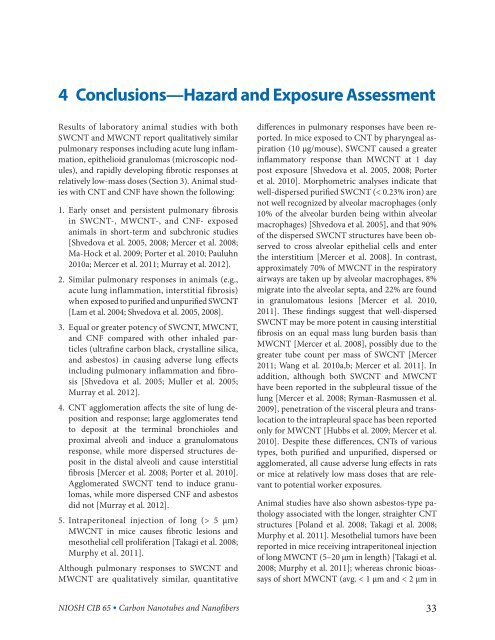Occupational Exposure to Carbon Nanotubes and Nanofibers
Occupational Exposure to Carbon Nanotubes and Nanofibers
Occupational Exposure to Carbon Nanotubes and Nanofibers
You also want an ePaper? Increase the reach of your titles
YUMPU automatically turns print PDFs into web optimized ePapers that Google loves.
4 Conclusions—Hazard <strong>and</strong> <strong>Exposure</strong> AssessmentResults of labora<strong>to</strong>ry animal studies with bothSWCNT <strong>and</strong> MWCNT report qualitatively similarpulmonary responses including acute lung inflammation,epithelioid granulomas (microscopic nodules),<strong>and</strong> rapidly developing fibrotic responses atrelatively low-mass doses (Section 3). Animal studieswith CNT <strong>and</strong> CNF have shown the following:1. Early onset <strong>and</strong> persistent pulmonary fibrosisin SWCNT-, MWCNT-, <strong>and</strong> CNF- exposedanimals in short-term <strong>and</strong> subchronic studies[Shvedova et al. 2005, 2008; Mercer et al. 2008;Ma-Hock et al. 2009; Porter et al. 2010; Pauluhn2010a; Mercer et al. 2011; Murray et al. 2012].2. Similar pulmonary responses in animals (e.g.,acute lung inflammation, interstitial fibrosis)when exposed <strong>to</strong> purified <strong>and</strong> unpurified SWCNT[Lam et al. 2004; Shvedova et al. 2005, 2008].3. Equal or greater potency of SWCNT, MWCNT,<strong>and</strong> CNF compared with other inhaled particles(ultrafine carbon black, crystalline silica,<strong>and</strong> asbes<strong>to</strong>s) in causing adverse lung effectsincluding pulmonary inflammation <strong>and</strong> fibrosis[Shvedova et al. 2005; Muller et al. 2005;Murray et al. 2012].4. CNT agglomeration affects the site of lung deposition<strong>and</strong> response; large agglomerates tend<strong>to</strong> deposit at the terminal bronchioles <strong>and</strong>proximal alveoli <strong>and</strong> induce a granuloma<strong>to</strong>usresponse, while more dispersed structures depositin the distal alveoli <strong>and</strong> cause interstitialfibrosis [Mercer et al. 2008; Porter et al. 2010].Agglomerated SWCNT tend <strong>to</strong> induce granulomas,while more dispersed CNF <strong>and</strong> asbes<strong>to</strong>sdid not [Murray et al. 2012].5. Intraperi<strong>to</strong>neal injection of long (> 5 µm)MWCNT in mice causes fibrotic lesions <strong>and</strong>mesothelial cell proliferation [Takagi et al. 2008;Murphy et al. 2011].Although pulmonary responses <strong>to</strong> SWCNT <strong>and</strong>MWCNT are qualitatively similar, quantitativedifferences in pulmonary responses have been reported.In mice exposed <strong>to</strong> CNT by pharyngeal aspiration(10 µg/mouse), SWCNT caused a greaterinflamma<strong>to</strong>ry response than MWCNT at 1 daypost exposure [Shvedova et al. 2005, 2008; Porteret al. 2010]. Morphometric analyses indicate thatwell-dispersed purified SWCNT (< 0.23% iron) arenot well recognized by alveolar macrophages (only10% of the alveolar burden being within alveolarmacrophages) [Shvedova et al. 2005], <strong>and</strong> that 90%of the dispersed SWCNT structures have been observed<strong>to</strong> cross alveolar epithelial cells <strong>and</strong> enterthe interstitium [Mercer et al. 2008]. In contrast,approximately 70% of MWCNT in the respira<strong>to</strong>ryairways are taken up by alveolar macrophages, 8%migrate in<strong>to</strong> the alveolar septa, <strong>and</strong> 22% are foundin granuloma<strong>to</strong>us lesions [Mercer et al. 2010,2011]. These findings suggest that well-dispersedSWCNT may be more potent in causing interstitialfibrosis on an equal mass lung burden basis thanMWCNT [Mercer et al. 2008], possibly due <strong>to</strong> thegreater tube count per mass of SWCNT [Mercer2011; Wang et al. 2010a,b; Mercer et al. 2011]. Inaddition, although both SWCNT <strong>and</strong> MWCNThave been reported in the subpleural tissue of thelung [Mercer et al. 2008; Ryman-Rasmussen et al.2009], penetration of the visceral pleura <strong>and</strong> translocation<strong>to</strong> the intrapleural space has been reportedonly for MWCNT [Hubbs et al. 2009; Mercer et al.2010]. Despite these differences, CNTs of varioustypes, both purified <strong>and</strong> unpurified, dispersed oragglomerated, all cause adverse lung effects in ratsor mice at relatively low mass doses that are relevant<strong>to</strong> potential worker exposures.Animal studies have also shown asbes<strong>to</strong>s-type pathologyassociated with the longer, straighter CNTstructures [Pol<strong>and</strong> et al. 2008; Takagi et al. 2008;Murphy et al. 2011]. Mesothelial tumors have beenreported in mice receiving intraperi<strong>to</strong>neal injectionof long MWCNT (5–20 µm in length) [Takagi et al.2008; Murphy et al. 2011]; whereas chronic bioassaysof short MWCNT (avg. < 1 µm <strong>and</strong> < 2 µm inNIOSH CIB 65 • <strong>Carbon</strong> <strong>Nanotubes</strong> <strong>and</strong> <strong>Nanofibers</strong>33

















